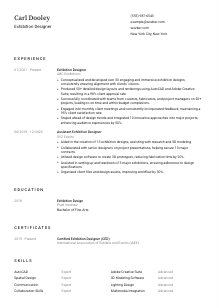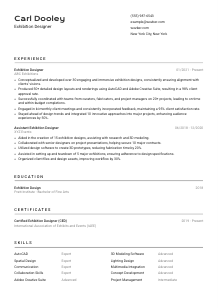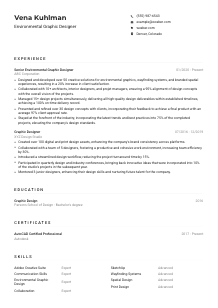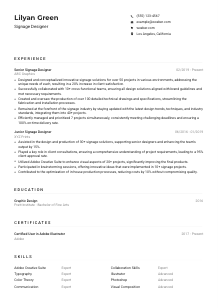Exhibition Designer Resume Example
Weaving exhibits, but your resume feels tucked away? Explore this Exhibition Designer resume example, set up with Wozber free resume builder. Discover how you can craft your design narrative to resonate with job prospectuses, ensuring your career stands tall amidst the gallery of opportunities!
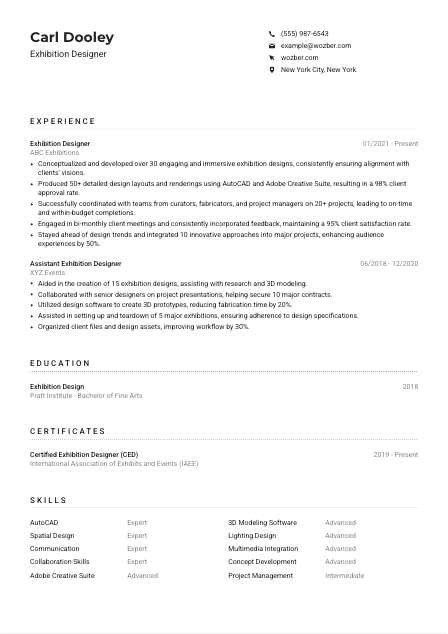
How to write an Exhibition Designer Resume?
Hello, future Exhibition Designer extraordinaire! In a realm where art and design merge to create immersive experiences, your resume is your personal exhibition. Using Wozber, a free resume builder that excels in ATS optimization, this guide will help you craft a resume tailored to land your dream role. With attention to ATS-friendly resume templates and insightful tips, get ready to design a resume that makes you shine in the competitive field of exhibition design.
Personal Details
Make no mistake, every exhibition begins at the entrance. Similarly, your resume kicks off with your personal details. It might seem straightforward, yet this is your opening statement. Here's how to ensure it's compelling and aligned with the Exhibition Designer position requirements.
1. Name as Your Brand
Think of your name as a bold title at the entrance of an exhibition. It should grab attention. Ensure it's in a prominent font size, making it the spotlight of this section.
2. Job Title Precision
Directly below your name, proudly state your professional title - "Exhibition Designer". This asserts your identity in the art and design world and aligns beautifully with the role you're applying for.
3. Contact Essentials
Your contact information is like the guide map for potential employers to reach out. Ensure your phone number is correct and your email address professional. A tip? An email format like firstname.lastname@example.com is always a safe bet.
4. Location Matters
"Located in New York City, New York" instantly meets one of the vital job requisites, showing recruiters you're in the right place for the role without the hassle of relocation.
5. Professional Online Presence
Including a LinkedIn profile can add depth to your resume, just like an interactive element enhances an exhibition. Ensure your LinkedIn is updated and echoes your resume's information.
Takeaway
Your personal details are the doorway into the vast exhibition that is your career. Designed correctly, it welcomes recruiters into your professional journey, presenting you as the perfect match for their Exhibition Designer role. Reflect professionalism while making sure every detail aligns with the job at hand.





Experience
Your experience is the main exhibit in your resume's gallery. It narrates your professional journey. For an Exhibition Designer, this section needs to be as detailed and captivating as the designs you've created. Let's delve into tailoring your experience to echo the requirements of your dream job.
- Conceptualized and developed over 30 engaging and immersive exhibition designs, consistently ensuring alignment with clients' visions.
- Produced 50+ detailed design layouts and renderings using AutoCAD and Adobe Creative Suite, resulting in a 98% client approval rate.
- Successfully coordinated with teams from curators, fabricators, and project managers on 20+ projects, leading to on‑time and within‑budget completions.
- Engaged in bi‑monthly client meetings and consistently incorporated feedback, maintaining a 95% client satisfaction rate.
- Stayed ahead of design trends and integrated 10 innovative approaches into major projects, enhancing audience experiences by 50%.
- Aided in the creation of 15 exhibition designs, assisting with research and 3D modeling.
- Collaborated with senior designers on project presentations, helping secure 10 major contracts.
- Utilized design software to create 3D prototypes, reducing fabrication time by 20%.
- Assisted in setting up and teardown of 5 major exhibitions, ensuring adherence to design specifications.
- Organized client files and design assets, improving workflow by 30%.
1. Decode and Map
Start with a keen eye, dissecting the job description. For instance, the role requires proficiency in AutoCAD and Adobe Creative Suite. Highlight experiences where you've effectively used these tools, just like showcasing your best works in an exhibition.
2. Structure with Precision
Present your professional timeline as you would a carefully planned exhibit. Start with your current or most recent role, ensuring each position is clearly marked with your job title, the company name, and the dates of your engagement.
3. Showcase Achievements
Detail your responsibilities and achievements so they reflect back to the job's needs. For example, "Conceptualized and developed over 30 engaging and immersive exhibition designs" directly correlates with the job description's call for someone who can develop immersive designs aligned with clients' visions.
4. Numbers Tell a Story
Quantifying your accomplishments give them weight. Mentioning a "98% client approval rate" or "enhancing audience experiences by 50%" provides tangible evidence of your success, similar to visitor numbers at a successful exhibition.
5. Relevancy is Key
Like selecting pieces for an exhibit, choose experiences that are most relevant. Focus on detailing projects and roles that speak directly to the skills and responsibilities mentioned in the job description.
Takeaway
Think of each job and project as a unique exhibit on your professional journey. Highlighting your experience with precision and care will draw the recruiter through your career gallery, proving that your path aligns perfectly with the Exhibition Designer role they seek to fill.
Education
The foundation of your career, your education section, should not just be a list of schools. It's about showcasing your preparedness for the role of Exhibition Designer. Let's sketch out how to tailor this section to reflect the necessary educational background.
1. Match the Degree
Identify the degree requirement from the job description - a Bachelor's degree in a related field. Explicitly mention your "Bachelor of Fine Arts in Exhibition Design", directly aligning with the employer's needs.
2. Keep It Structured
Structure this section for easy reading. Start with the degree, followed by the field of study, and the institution. Mention the year of graduation to provide a timeline.
3. Echo the Job Requirements
The job demands specific educational qualifications. Ensure your degree matches this. If you have a degree in a closely related field, mention any relevant coursework or projects that bridge any gaps.
4. Course Highlights
If you've taken specialized courses that enhance your qualifications for the Exhibition Designer role, list them. This could include courses in 3D modeling or lighting design, for example.
5. Achievements and Extras
Have you shone in your educational journey with honors, or engaged in extracurricular activities relevant to design? Mention these to add depth to your educational narrative, showing your passion extends beyond the classroom.
Takeaway
Your education section is the blueprint that shows you've built a solid foundation for your career as an Exhibition Designer. It should communicate not just where you studied, but how your educational journey prepares you for the challenges and opportunities of the role at hand.
Certificates
In the ever-evolving field of exhibition design, certifications can serve as highlights in your career narrative, showing your commitment to professional growth and mastery of your craft. Here's how to illuminate this section with certifications that resonate with the Exhibition Designer role.
1. Relevance Over Quantity
Quality trumps quantity. List certifications that directly align with the job's requirements or enhance your expertise in areas like design software or project management. Our example mentions "Certified Exhibition Designer (CED)", directly relevant to the role.
2. Up-to-date Achievements
Ensure your certifications are current. If the certification is ongoing, like the "2019 - Present" timeline for a CED, it signals to potential employers your continuous commitment to staying relevant in your field.
3. Transparency with Dates
For certifications, the dates matter. They provide context about how current your knowledge and skills are. Always include the date acquired or the validity period if applicable.
4. Continuous Learning
The design world is dynamic, with new trends and technologies emerging regularly. Show that you're committed to your professional development by pursuing relevant certifications and keeping your skills sharp and up-to-date.
Takeaway
By strategically showcasing your certifications, you not only demonstrate your skill level and commitment to your craft but also distinguish yourself in the competitive field of exhibition design. Make this section a testament to your unwavering dedication to excellence.
Skills
The skills section is where you get to shine a spotlight on your professional toolkit. For an Exhibition Designer, this is an opportunity to showcase the blend of creative and technical skills that make you the ideal candidate. Let's craft a skills section that captures the essence of your expertise.
1. Extract From Requirements
Carefully read the job posting and identify both the hard and soft skills mentioned. Skills like "AutoCAD proficiency" or "strong communication" are keys that unlock the door to an interview.
2. Prioritize and Match
Choose skills from your arsenal that match the job description. For instance, if the job requires expertise in "Adobe Creative Suite" and "3D modeling software", and you excel in these areas, make sure they're front and center.
3. Clarity and Focus
Steer clear of overloading this section. Instead, offer a concise list of skills where each item holds significant weight in the context of the Exhibition Designer role. Think of it as curating an exhibition: only the most impactful pieces make it to the floor.
Takeaway
Just as an expertly curated exhibition leaves a lasting impression, a well-crafted skills section draws the recruiter's attention to your unique strengths. By aligning your skills with the requirements of the role, you paint a picture of yourself as the perfect fit for the position.
Languages
The world of exhibition design often crosses cultural and linguistic boundaries. The ability to communicate in multiple languages can significantly enhance your profile. Let's navigate the linguistics landscape and set your resume apart in a global field.
1. Key Language Requirements
First, identify if the job description specifies any particular language skills. In our example, "strong English language skills" are a must, which should be prominently listed as your primary language proficiency.
2. Showcase Your Linguistic Palette
Beyond the primary language, list any additional languages you are fluent in. This adds color to your resume, showing potential employers your ability to communicate in diverse settings.
3. Honesty in Proficiency
Accuracy in representing your language skills is crucial. Use terms like native, fluent, intermediate, and basic to provide a clear understanding of your proficiency.
4. Global Perspectives
In a role that might require understanding diverse cultural contexts, showcasing language skills can be a strong advantage. It suggests you're well-equipped to communicate effectively in a multicultural environment.
5. The Impact of Communication
In exhibition design, where understanding client vision and collaborating with international teams can be part of the job, your language skills underscore your ability to navigate these interactions seamlessly.
Takeaway
Languages are more than just words; they're bridges to understanding, collaboration, and cultural exchange. Highlighting your linguistic skills showcases not only your communication abilities but also your readiness to thrive in a global marketplace.
Summary
The summary is your chance to intrigue and inform, to tie all your professional threads into a compelling introduction. For an Exhibition Designer, this means articulating your unique blend of creativity, technical skill, and experience in concise, vivid detail. Let's craft a summary that captures your professional identity.
1. Capture the Job Essence
Begin by absorbing the essence of the job description. This will guide you in highlighting your qualifications that are most relevant to what the employer is seeking.
2. Start with a Strong Opening
Introduce yourself as an Exhibition Designer, confidently stating your years of experience and your core expertise. This establishes your professional standing right from the start.
3. Reflect the Requirements
Mention skills and achievements that resonate with the job requirements, such as "developing engaging and immersive exhibition designs" or your proficiency in design software, to demonstrate your preparedness for the role.
4. Precision and Brevity
The art of summarizing is to be both concise and compelling. Keep your summary to a few impactful sentences that invite the hiring manager to delve deeper into your resume.
Takeaway
Your summary is the prologue to your professional narrative. Craft it with care, ensuring it's a powerful, precise introduction that aligns with the Exhibition Designer role. This section sets the tone for your resume, seducing recruiters into wanting to explore the depth of your experiences and skills.
Embarking on Your Exhibition Designer Journey
Congratulations on completing your guided tour through crafting a resume tailored for an Exhibition Designer role. Remember, your resume is a dynamic showcase of your professional story, designed to capture the attention and interest of potential employers. With Wozber, leveraging free ATS-friendly resume templates and the ATS resume scanner, your resume will not only be a reflection of your skills and accomplishments but also optimized for success in the digital age.
Now, go forth and let your career narrative unfold in the hands of eager hiring managers. The stage is set for you to shine.

- Bachelor's degree in Exhibition Design, Interior Design, Industrial Design, or a related field.
- Minimum of 3 years of relevant experience in exhibition design or related field.
- Proficiency in design software such as AutoCAD, Adobe Creative Suite, and 3D modeling software.
- Strong understanding of spatial design, with the ability to effectively utilize various design elements including lighting, sound, and multimedia.
- Exceptional communication and collaboration skills, with the ability to liaise with clients, artists, and other stakeholders.
- Must possess strong English language skills.
- Must be located in New York City, New York.
- Conceptualize and develop engaging and immersive exhibition designs, ensuring they align with clients' vision and thematic mandates.
- Produce detailed design layouts, renderings, and technical drawings using appropriate software and tools.
- Coordinate with cross-functional teams, including curators, fabricators, and project managers, to ensure successful execution of projects.
- Engage in regular client meetings and presentations, incorporating feedback to ensure client satisfaction.
- Stay updated on design trends and industry standards, integrating innovative approaches into projects.





